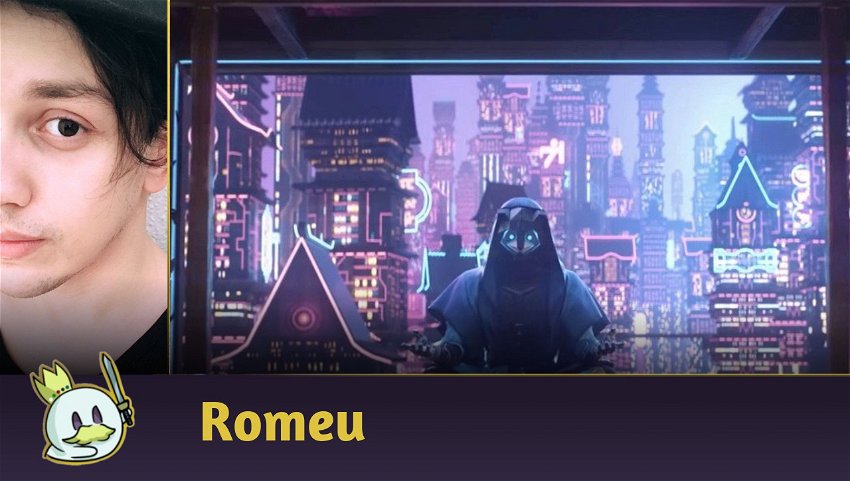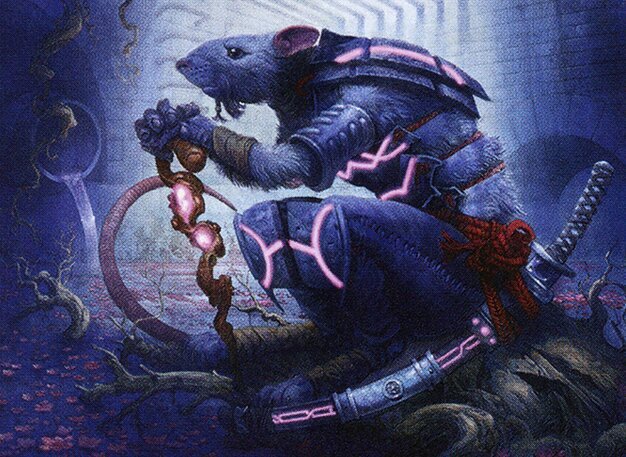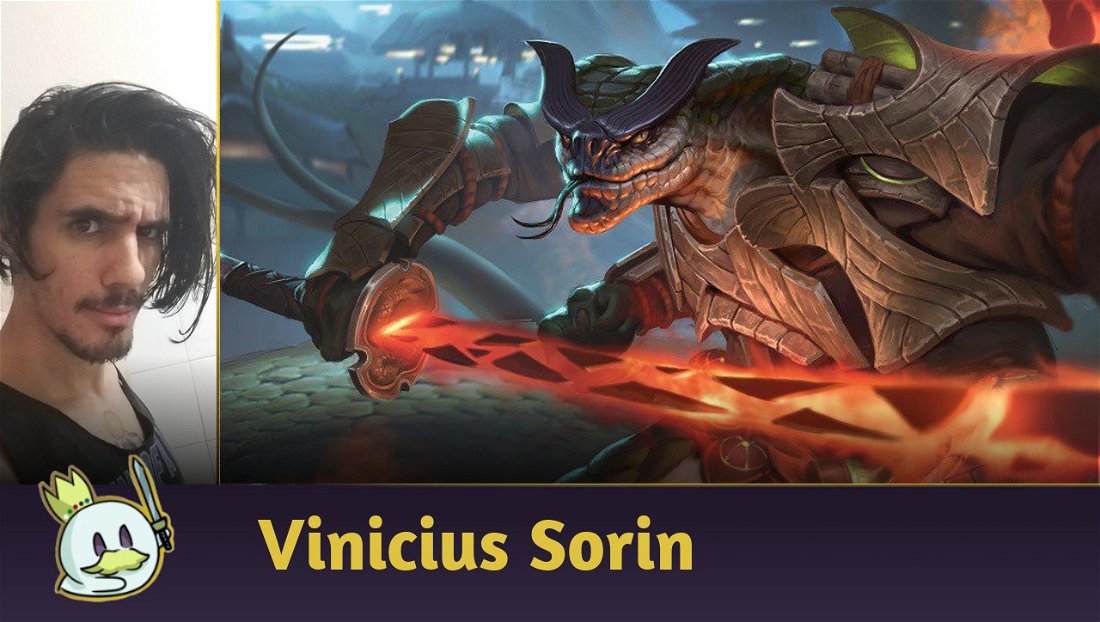With the first weekend of tournaments following Kamigawa: Neon Dynasty's release on digital platforms, we can get a sense of the impact the new set has had on competitive formats, what ideas are being tested and which decks are being played, and what we can look forward to at upcoming events and weeks.
Today, I bring you a compilation of the main decks with inclusions from the new set in Constructed formats in this weekend's Challenges and Qualifiers!
Standard
Jeskai Hinata
Ad
Let's start with Standard's main new deck, Jeskai Hinata, which takes advantage of Hinata, Dawn-Crowned's ability to significantly reduce the cost of spells like Shatterskull Smashing, as well as Prismari Command, Lorehold Command and even being able to cast Magma Opus for just two mana.
The highlight of this list is that it's already a very efficient Midrange, and Hinata's 4/4 body is naturally good for its mana cost, making her inclusion as a threat alongside Goldspan Dragon come with pretty much no drawbacks and all possible bonuses if she remains in play.
In particular, I see this archetype as the near future best deck in Standard, perhaps to the point of being absolutely broken, and the fact that it has achieved so many placements in this weekend's tournaments feels like a testament to its potential.
The question now is whether the Metagame will be able to adapt, or if Hinata will dominate the game enough to make the format play around her.
Mono-Red Aggro
And perhaps a viable option for dealing with Jeskai Hinata is to set up a lot of pressure really fast, and what better way to do that than with Mono Red Aggro, built by Willy Edel himself?
Neon Dynasty has brought so many good one-drops to Mono-Red that it can always count on at least one or two in its starting hand, and sequences involving Kumano Faces Kakkazan with any two-drop create swift openings and difficult for the opponent to follow without equally fast answers.
With this list, Chandra, Dressed to Kill also finds her place in Standard, and can establish a significant advantage the turn she comes into play by being able to cast another creature or spell on the same turn, while also offering some card advantage on later turns, or grants the fourth mana to play Thundering Raiju, which with so many ways to equip or put counters on creatures, becomes a must-answer threat.
A highlight, for me, is Ogre-Head Helm, which doesn't have a spectacular body and doesn't offer as much pressure in early game, but offers a relevant buff on a creature in longer matchups, and can be sacrificed to replenish your resources after you empty your hand in the first few turns, making it a powerful option — as this deck has the clear goal of playing as many threats for as little cost as possible.
Azorius Control
Another archetype that caught my eye this weekend was Azorius Control, which runs a total of eighteen Neon Dynasty cards.
The Wandering Emperor was a relatively obvious addition to a Draw-Go list, as it serves as both removal and threat in the same slot and being able to play it with Flash makes a huge difference for this kind of strategy, and March of Otherworldly Light joins it as a powerful and efficient removal that can adapt to countless situations.
Channel Lands are also essentially perfect for this strategy as well, as they offer more resources that can be used in late-game, while also guaranteeing untapped land drops. My surprise is the inclusion of Spirited Companion, but I suppose a two-drop that replaces itself and is a good blocker really deserves its spot.
Ad
Rakdos Control
Another interesting appearance this weekend was Rakdos Control, which placed 12th in the Standard Challenge, and despite the inclusion of Biting-Palm Ninja and Junji, the Midnight Sky, in addition to Reckoner Bankbuster as an additional threat, the highlight of the list definitely goes to Invoke Despair.

Currently, in a regular game, Invoke Despair will be a Cruel Edict which, for an additional cost of three mana, allows you to draw two cards and make your opponent lose 4 life, basically being a mini-Cruel Ultimatum for two less mana, while in other games, this spell will commonly deal with three opponent's permanents with just one card.
As Invoke Despair makes the opponent sacrifice the creature, it also means that it deflects Goldspan Dragon triggers, a very relevant bonus in the current Metagame.
These weren't Neon Dynasty's only additions to Standard: The format's then-best deck, Orzhov Midrange, found space to include Ao, the Dawn Sky and Eiganjo, Seat of the Empire to its maindeck, while The Wandering Emperor starts appearing as a sideboard option.
Mono-Green Aggro has adopted Invoke the Ancients, as paying five mana to have two 4/5 bodies on the board seems like a fair trade, plus Reckoner Bankbuster as a threat easily crewed by its creatures, and which also offers some card advantage on longer matchups.
In addition to these lists, several other archetypes appeared in this week's Leagues. However, because of the win trading schemes that have been taking place on Magic Online, especially at Standard, I chose not to mention any of these lists in this article.
Pioneer
Jund Anvil
Oni-Cult Anvil was a great upgrade to the Sacrifice archetypes by allowing interactions with artifacts such as Food, Treasure, among others. But the highlight of this new list is not just the new artifact, but the inclusion of Karn, the Great Creator to add a toolbox to the list, including the possibility to reduce the number of Witch's Oven and Bolas's Citadel in favor of greater diversity of sac outlets.
Plus, with the format being so focused on artifacts and decks like Ensoul and Esper Parhelion emerging as competitive options, Karn's static ability does a fantastic job of significantly disrupting any artifact-based strategy.
A Rakdos version also appeared at this same event to take full advantage of the sacrifice effects with Terrarion and Experimental Synthesizer, but I think the Jund version will stand out better in the coming weeks.
Esper Parhelion
One of the most exciting options with the launch of the new set was the cards that interact remarkably well with one of War of the Spark's most despised rares: Parhelion II, to the point of making it a competitively viable option on Pioneer.
The inclusion of Greasefang, Okiba Boss, gives room for a player to take advantage of the gigantic vehicle to practically win the game in two turns for a very low cost, as it will attack for 13 damage alongside its Angel tokens, which will remain on the battlefield even if the vehicle leaves play.
Ad
Coupled with the creation of an efficient shell to activate the vehicle even without a creature through Tezzeret, Betrayer of Flesh and Mech Hangar, in addition to the reprint of Thirst for Knowledge, Neon Dynasty opens space so that a strategy aimed at winning the game with a gigantic battleship and its army of angels becomes a reality in the format.
Azorius Ensoul
Speaking of artifacts, Ensoul decks have received some great additions, especially Michiko's Reign of Truth, which functions as a pseudo-Cranial Plating for two turns before becoming a threat on its own when it transforms, but the list above also found room for the inclusion of Eater of Virtue, which absorbs the abilities of dead creatures attached to it, making it devastating alongside a Stonecoil Serpent, but also being useful alongside Gingerbrute or Alseid of Life's Bounty.
Orzhov Auras
As expected, Light-Paws, Emperor's Voice joined Sram, Senior Edificer in Orzhov Auras, giving the archetype enough consistency to, after a few months, reach the Top 8 of a Pioneer Challenge, as well as being widely played in Leagues and Preliminaries, which could mean its return to the Metagame.
It's worth mentioning that Kaya's Ghostform, a standard Auras card in Pioneer, is (or was, it's been reported to have been fixed) bugged in Magic Online, and the archetype would likely be even better with its inclusion.
Rakdos Aggro
In Leagues, an interesting proposal that emerged this weekend was Rakdos Aggro, which seeks to take advantage of Rakdos Blood's lower curve with Mono-Black Aggro's aggressive drops to establish a shell powerful enough that Mukotai Soulripper may prevail as a threat.
Another highlight of the list is Reinforced Ronin as a powerful one-drop that can also crew Mukotai Soulripper, while offering a recurring flow of card advantage alongside Lurrus of the Dream-Den in Late-Game.
Paradoxical Outcome
Moonsnare Prototype allows artifact decks to have a powerful mana boost which, alongside Mox Amber and other 0-cost artifacts, makes it possible to cast Sai, Master Thopterist quickly.
After playing multiple 0 or 1 mana artifacts, its goal is to return as many permanents to your hand as possible with Paradoxical Outcome to draw a ridiculous amount of cards, then cast Hullbreaker Horror along with Aetherflux Reservoir to cast a 0-mana spell infinitely, bouncing it with Hullbreaker Horror, to gain infinite life and deal infinite damage.
Modern
Azorius Hammer
Kamigawa gave more reason for Hammer Time players to adopt the Azorius version of the list, which was already becoming popular due to some maindeck and sideboard options.
Lion Sash and The Reality Chip count as creatures that can hold a Colossus Hammer or other equipment if needed, but can also be fetched by Stoneforge Mystic for specific situations.
In addition to also being a great graveyard hate in the Maindeck, Lion Sash is a viable threat option in longer matchups when feeding from both players' graveyards, and can grow it or any creature reconfigured with it to stratospheric levels.
Ad
The Reality Chip doesn't do much on its own, but when attached to any creature, it offers a huge card advantage in a format that includes means of clearing the top with Fetchlands, and in an archetype with such low costs, it will often be necessary to remove it from the battlefield before it makes its controller dominate the game.
I'm sure Lion Sash will still be widely played in Hammer Time and other Stoneforge Mystic decks, but only time will tell how much The Reality Chip is necessary and viable for Modern.
Amulet Titan
For Modern, Boseiju, Who Shelters All is probably the best of the Channel Lands cycle, as there are a plethora of legal targets for it in the format and with almost zero deckbuilding concession cost for most of the lists that are interested in having copies of it, and apparently, four copies is never enough for such an efficient answer, as proven by Modern Premier's winning list.
Selesnya Taxes
And it's not just archetypes like Amulet Titan, which has a very high land count, that we see four copies of Boseiju, Who Shelters All: the player Parrit ranked seventh in the same event with a Selesnya Taxes list which includes the Boseiju playset, alongside Stoneforge Mystic and Lion Sash.
Mono Blue Faeries
No, I'm not in the Pauper section yet.
And looking at the Leagues results, I came across this Mono-Blue Faeries that tries to take advantage of Moon-Circuit Hacker and Ninja of the Deep Hours with Spellstutter Sprite and Faerie Seer, as in Pauper, and using essentially the same spell base, but with the necessary adaptations to the format.
Pauper
Kuldotha Boros
Kuldotha Boros is back in Pauper, after years of being replaced by Monarch-based variants.
Having an extra Ichor Wellspring effect with Experimental Synthesizer gives a great reason to play Kuldotha Rebirth at Pauper, along with the famous Glint Hawk + Kor Skyfisher package that seemed an obsolete way of obtaining card advantage in the format today, but that can still work very well in a more aggressive game proposal.
The addition of Makeshift Munitions to the format also significantly helps decks like this to get the most value out of their permanents, including the tokens created by Kuldotha Rebirth.
Other versions of the Kor Skyfisher + Glint Hawk + Experimental Synthesizer set have appeared, such as this one that seeks to take full advantage of Makeshift Munitions and the Bounce effects of Kor Skyfisher alongside Voldaren Epicure.
Rakdos Affinity
Experimental Synthesizer was also present on Affinity lists, but the highlight of Neon Dynasty for the archetype currently is Reckoner's Bargain which, when cast together with Frogmite or Myr Enforcer, can guarantee a huge amount of extra life, plus two more cards in your hand, being very relevant even against decks other than Burn when the Metagame is so focused on attacking you with small creatures like this last week.
Ad
Mono Blue Faeries
Despite the initial community panic, Mono Blue Faeries didn't perform significantly well in this weekend's Challenges, with only one Top 8, but the inclusion of Moon-Circuit Hacker definitely went a long way towards making the monocolored version of the archetype finally return to the Metagame with added consistency.
However, it is important to mention that the Izzet and Dimir versions are also experimenting with the new Ninja, especially in a scenario where the Monarch is no longer so favorable due to how many decks are trying to fill the board with small creatures, and it is possible that two copies of Moon-Circuit Hacker will also be adopted in these variants.
Legacy
While the new release hasn't made any major changes to Legacy so far, Channel Lands are being extensively tested in the most diverse decks in the format, and other one-of inclusions are appearing in specific archetypes, such as Lion Sash in Death & Taxes.
Conclusion
Kamigawa: Neon Dynasty's impact was significantly relevant in its first week, and opens up several possibilities, which need to be specifically refined, especially in Standard, Pioneer and Pauper.
Over the next few weeks, we'll see how players adapt to the new lists and additions, and we're sure to also see other archetypes popping up and merging in the Metagame, and we'll likely get a better look at how the new set has changed the competitive landscape.
Until then, our best bet is to sit back, watch and enjoy the game, each in their own way, as there is still plenty of room to explore new options and interactions with the new cards in each format.
Thanks for reading!








— Comments0
Be the first to comment